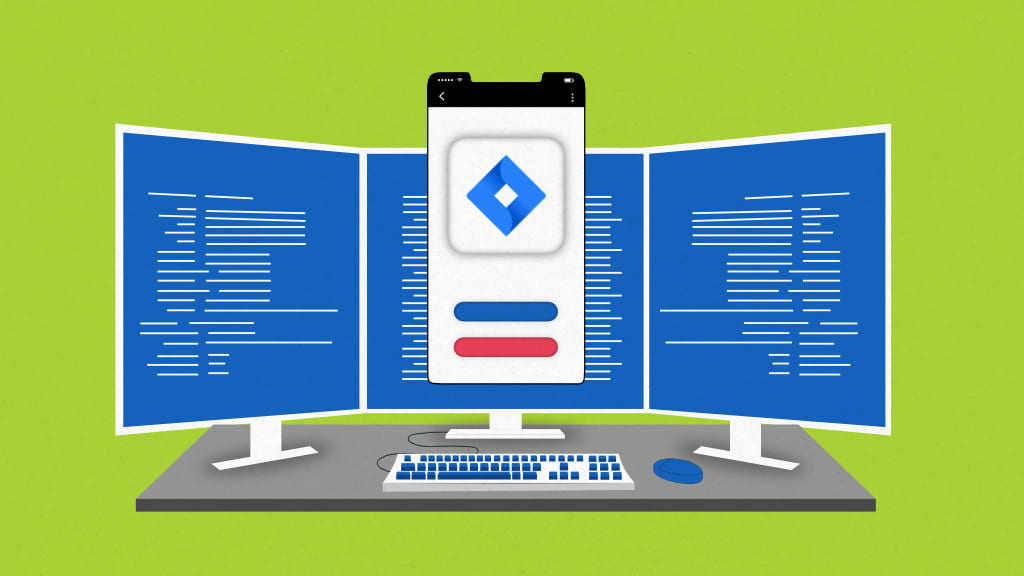Getting all your team members on the same page is the most demanding task in project management.
And if a specific task in your project requires input from employees in another department, you are doomed.
But what if I tell you that you can manage the entire workflow in your business on a powerful central dashboard?
This is what Jira Work Management is specifically built for. This tool helps you simplify and manage complex projects. Irrespective of your employees’ department, you can easily manage and control the overall business workflow.
This article will help you understand the basic functionalities of this tool and help you uncover its full potential. Plus, our user-friendly guide makes it easy for you to discover the tool’s full power step by step, so you can make the most out of it effortlessly.
What is Jira Work Management?
Jira Work Management (JWM) is a specialized platform for business teams across HR, finance, marketing, legal, sales, and operations to streamline workflow across multiple departments. This tool comes from the Atlassian marketplace and is available free of cost with the Jira software.
JWM plays a significant role in bringing employees in different departments together. You can collaborate to work on complex projects. Users can create shared workspaces to organize, track, and document business projects.
If you are looking for an alternative to Jira Work Management, here are theTop 13 Work Management Software for businesses!
What is Jira Work Management used for?
Jira Work Management is a tool that is designed to enhance collaboration among team members. This helps businesses streamline and define a clear workflow. You can enhance interdepartmental collaboration and ensure a seamless flow of projects.
You can create customized workspaces in JWM to organize, document, and track work. This creates a transparent view that lets your team members be notified of what tasks are done, what tasks are in progress, and what tasks are coming up next.
Furthermore, JWM enhances interdepartmental real-time collaboration among your team members.
The different use cases include:
- Human resources
- Marketing
- Operation
- Sales
- Finance
- Design/Development
Jira Work Management provides you with customizable templates for each of these use cases.
Understanding Atlassian’s Jira Work Management
Jira Work Management is free along with every Jira software that you buy. While Jira software is generally preferred by software development teams, JWM provides you with the power of Jira software that can be harnessed by business teams.
JWM integrates with more than 500+ other tools and 3000+ extensions that fulfill the typical requirements of individual businesses. Let’s explore the key functionalities of this platform and the steps to onboard.
Key features and functionalities
JWM provides you with numerous features and functionalities that help business teams organize and streamline work processes. The key features and functionalities include
1. Multiple task list views
Managing business projects requires wide visualization and multiple angles for unique perspectives. JWM provides you with multiple view options such as list view and calendar view that are not available in the Jira software.
2. Security controls
You can lock sensitive tasks and provide access to only the necessary team members. This is necessary when working on projects where you handle confidential information.
3. Task dependencies
You can define a clear work order. This will ensure that your team members are aware of the order in which they need to work on different tasks. This will enhance interdepartmental collaboration and the timely completion of tasks.
4. Automation
You can define work orders, rules, and principles that will minimize manual effort in managing repetitive tasks.
5. Templates
Jira Work Management tool provides you with customizable templates. You can choose a template based on the niche of your business. The customization options help you in precisely building the workflow of your choice.
6. Custom field reporting
You can generate advanced reports and insights on the performance of your team members. With 30+ custom fields, you can generate reports that help you understand the weak spots clearly. This will help you take improvement steps with ease.
Jira Work Management pricing
There is a free forever plan with a limit of up to 10 users. The storage is also limited to 2 GB in this plan.
The Standard plan costs $5/user/month when billed monthly. You have storage availability of 250 GB in this plan.
The Business plan costs $10/user/month when billed monthly. There is unlimited storage in this plan. Also, you get 24/7 premium support in this plan.
In comparison to other work management tools in the market, JWM is slightly priced higher. The per-user fees add up based on the people in your business. Tools like ProofHub with flat pricing come in handy and support scalability in your business.
Explore 24 best Jira alternatives & competitors for agile project management!
How to get started with Jira Work Management
If you already own a license to the Jira software, you will get free access to the Jira Work Management tool as well. But if you are new to Jira, you will have to start a subscription of your choice. You can refer to the previous section for information about the subscription charges.
I would recommend first-time users to opt for the free plan, to get used to the interface. You can then choose a suitable plan if you are comfortable with the interface.
The below steps will guide you through the initial onboarding process in Jira Work Management.
Step 1 – Select a template
Jira Work Management makes it simple to onboard. You get several customizable templates that will help you build the workflow of your choice with ease.
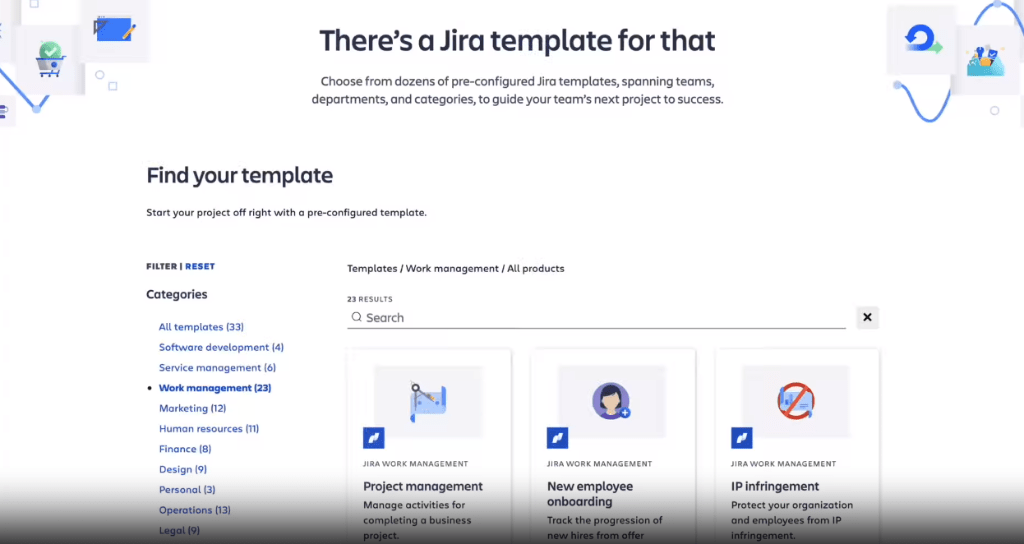
Step 2 – Choose your comfortable visualization option
JWM provides you with wide visualization in the form of multiple task list view options. Different view options help you gather different perspectives that help you plan and manage resources accordingly. The most common and widely used views include board, list, calendar, and timeline. The Summary view provides you with a quick overview of the project and helps you in preparing reports.
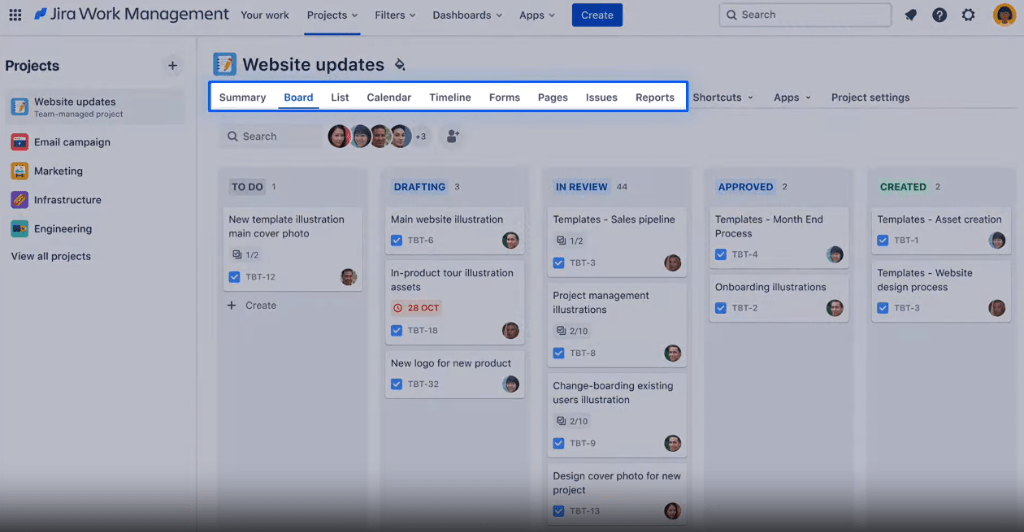
Step 3 – Customize your dashboard
Feeling at home is necessary to ensure that your team members feel comfortable with the tool. This is what JWM does best. You can customize the background color to match your project’s vibe and feel.
You can even change the project icon by uploading any image of your choice.
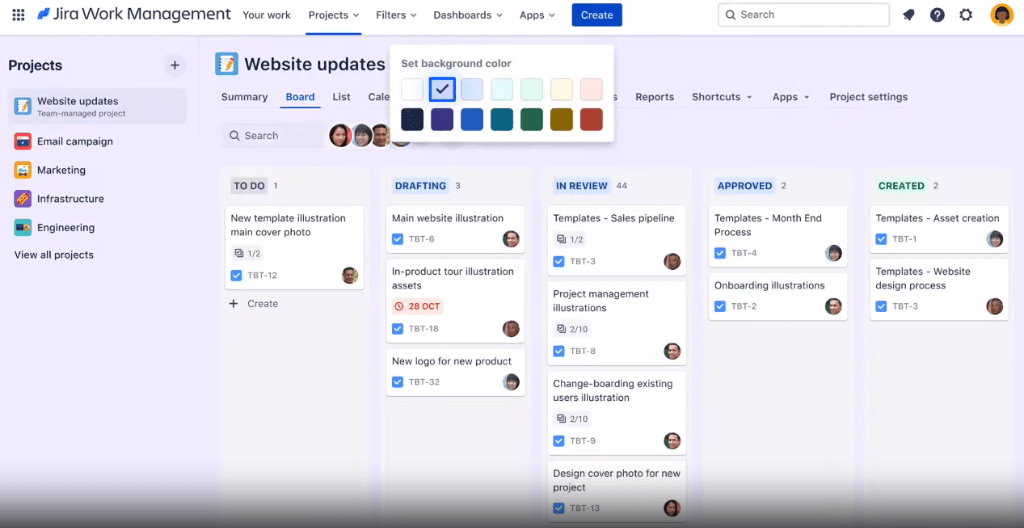
Step 4 – Create your first issue
JWM also mentions single tasks as issues. So create your first issue by entering the summary and other details about the task. Once you are done, hit the ‘create’ button.
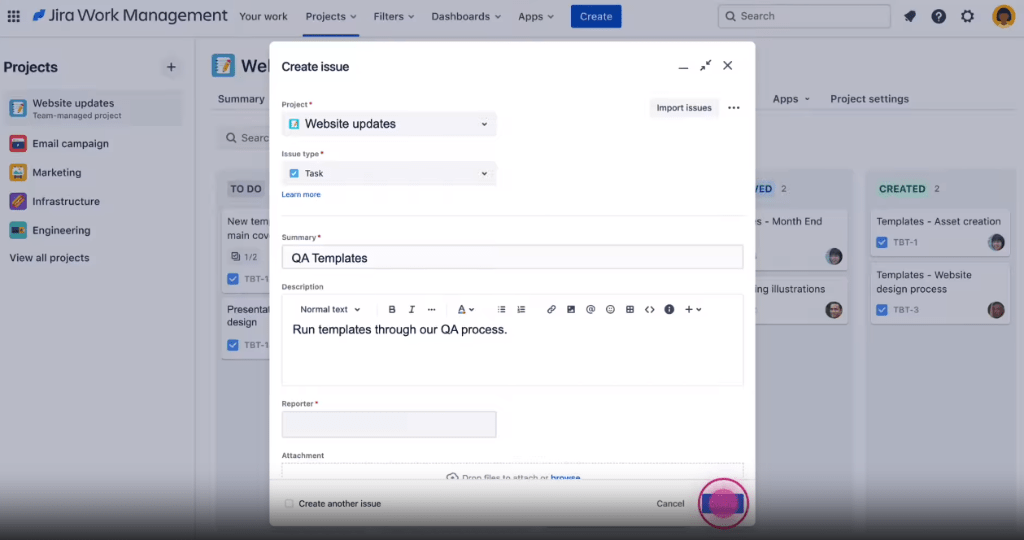
Step 5 – Onboard your team
After adding issues to your workspace, you need to send out invites to your team members. You can assign issues to your team members and by defining user roles and permissions you can control their access on the platform.
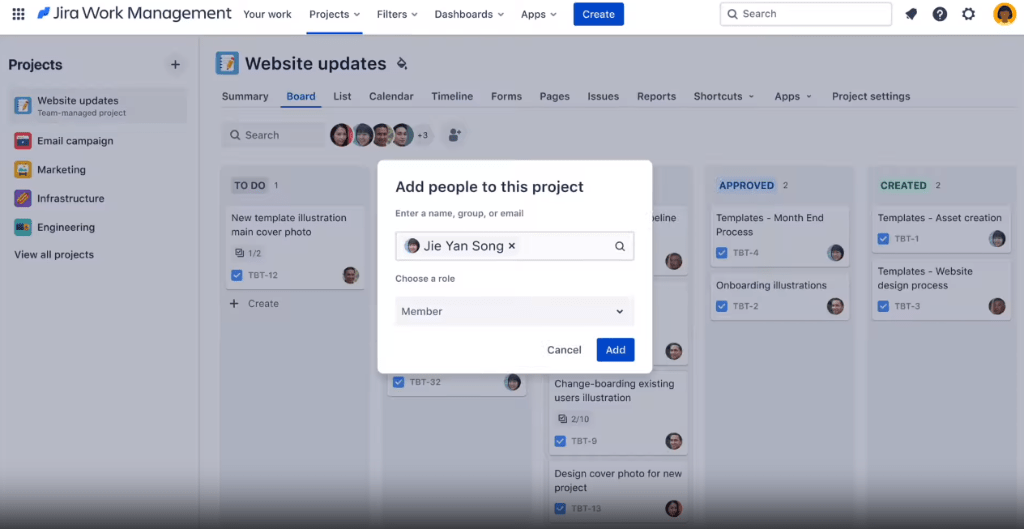
Step 6 – Integrate with other tools
It is now time for you to connect other tools that you are currently using. With 500+ integrations and 3000+ extensions, you can build your JWM to function seamlessly through the duration of your entire project.
You can find the necessary tools that you want to link to JWM in the Atlassian marketplace.
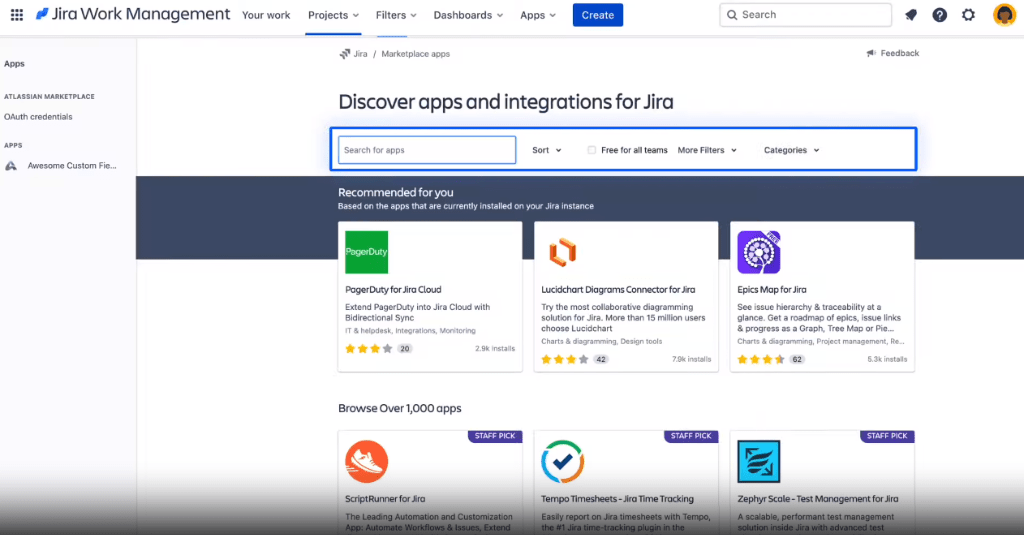
Step 7 – Automate your workflow
Once your team starts using the workspace, you will need automation to minimize repetitive manual effort. JWM further provides you with pre-defined templates for automating your workflow. Also, you can use the ‘create rule’ button to define an automation as per your workflow.
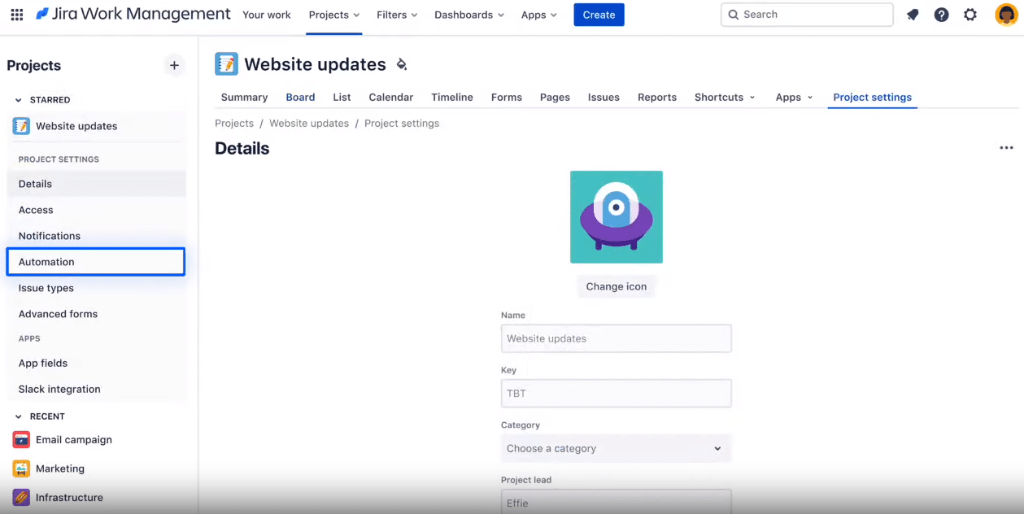
Additionally, you can refer here for the detailed procedure.
The templates are available here.
Jira Work Management vs. Jira software
Jira Work Management slightly varies from the Jira software. The key difference is that JWM provides you with a list view and a calendar view. These task list view functionalities are not available in the Jira software.
The key differences include
- Workflow
JWM is suitable for teams in any business. With customizable templates, you can quickly build a workflow and onboard your team members. Different teams with different niches like HR, sales, marketing, finance, and many other disciplines can use Jira for work management.
Jira software is generally limited to software development teams. The workflow is generally differentiated based on the Agile project management methodology they follow. The most preferred workflow in Jira software includes Scrum, Kanban, DevOps, and issue and bug tracking.
- Task list views
JWM provides you with multiple task list view options. This makes it easy for you to view tasks, monitor progression, and identify potential roadblocks. With Jira Work Management Premium, you can use the Overview to get a detailed view of the project. This is a combination of the calendar view, timeline, and summary view.
Jira software on the other hand is limited to sprints or user stories. The view is generally in the form of a board or a timeline. Additionally, the collaboration functionalities also depend on the workflow of the team. Teams working on Scrum use backlogs and a board to display the work process during a single sprint. Whereas teams working in Kanban use boards to visualize, track, and manage a continuous delivery of work.
Are you overwhelmed with the Kanban board view in Jira? Read this article – Jira Kanban Board: Find A Better Alternative 2025!
Which Jira product is best for your team?
Jira Work Management is built for businesses of all sizes and types. You can choose from a long list of pre-defined customizable templates to get started. Once you onboard your team members on this tool, you can manage the entire workflow on the central dashboard.
While Jira software is mostly suited for software development teams for tracking issues and bugs. Teams working on Agile methodologies such as Kanban or Scrum can use this software to streamline their process.
The choice between JWM and Jira software depends completely on the nature of the workflow in your organization.
However, apart from the separate use cases, Atlassian reports that more than 43000 teams across the globe use a combination of Jira software and Jira Work Management tool. So why do they do this combination?
- By creating dependencies between JWM and Jira software, you can ensure that critical issues and bugs are not overlooked before the launch of the software.
- You can create automation to link issues from Jira software with JWM, providing a transparent view of the work progression to the entire team.
- You can share estimated software release dates to the calendar in JWM for planning your GTM campaigns effectively.
- You can generate cross-project reports to understand the overall performance of your employees in multiple facets.
Explore the 11 best project management software for your team to manage workflows in your business!
Why use Jira Work Management?
Jira Work Management is a popular tool to enhance work management in business. This tool is used by different businesses in different domains and niches because of the customizable templates.
Benefits of Jira work management for business teams
JWM provides you with a unified platform for managing team members from different departments. The top benefits include
1. Multiple task list views
With JWM you get multiple view options for managing your workflow. The different views provide you with multiple perspectives for managing the projects. This helps you and your team members to focus on the crucial tasks and eliminate potential bottlenecks with ease.
2. Seamless workflow
Integrate JWM with Jira software and other tools to build a truly seamless workflow. This helps you build a central source of truth for managing projects from start to finish.
3. Automation
JWM provides you with automation templates that help you minimize manual effort in managing tasks. You can focus your attention on critical tasks instead of spending time on redundant activities.
4. Customizable templates
JWM provides you with highly customizable templates that help you in quick onboarding to the platform. Further, you can create your workplace with ease as per the typical workflow in your business.
Jira Work Management limitations
Although JWM is suitable for businesses in multiple domains, there are a few limitations that users have pointed out. The most common challenge pointed out by multiple users is related to the complexity of the tool. A complex tool takes a long time for initial set-up and configuration. You will have to provide additional training and tutorials for your team members.
Let’s see what past users say about JWM.
- Some users have mentioned that reporting features are difficult to understand for average users.
- Due to various options and menus, the interface is too complicated and it can be overwhelming for new users.
- Setting up and configuring Jira Work Management can be difficult, especially for non-technical users.
- Limited customization options for dashboards.
- Creating dashboards is difficult, and not all options are available for filtering.
- Not well suitable for short-term projects.
- Steep learning curve, training both admin and user roles is challenging, resulting in the loss of productive hours.
Where there are limitations there comes a way to overcome them. You can always look for solutions that are comfortable and best suited for your use case. The closest alternative is ProofHub which provides you with an all-in-one platform for managing the workflow of your business.
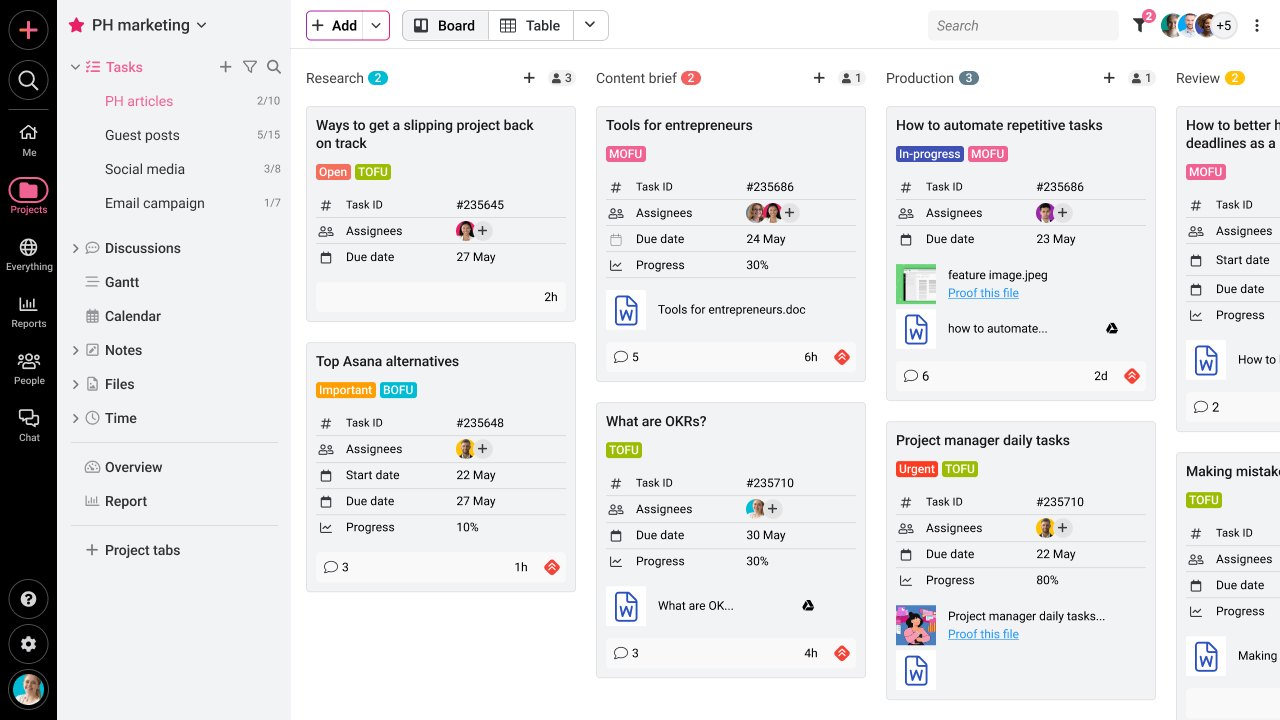
ProofHub is an all-in-one project management and team collaboration tool suitable for businesses of all sizes and domains. The key functionalities of ProofHub include:
- ProofHub combines project management, communication, collaboration, and file sharing into one platform, eliminating the need for multiple tools.
- ProofHub is praised for its user-friendly interface, making it easier for team members of all technical levels to adopt.
- ProofHub allows you to customize workflows to suit your specific project needs, giving you more flexibility than JIRA’s out-of-the-box options.
- ProofHub offers features like discussion boards, chat, and announcements, enhancing team communication and reducing reliance on external tools.
- ProofHub generally has lower pricing tiers than JIRA, making it a more budget-friendly option for smaller teams or startups.
Start your free trial now and discover why ProofHub is the superior choice for efficient and collaborative project workflows. Try ProofHub for free
Conclusion
Jira Work Management is the most effective platform for businesses to manage their team members on the central platform. You can manage interdepartmental projects with ease.
Additionally, JWM is like a gateway that connects your team members to a host of Atlassian software and tools. This helps you build a seamless workflow for managing projects from start to finish.
FAQs
What are the types of workflows in Jira?
Jira generally provides you with two different types of workflow – company-managed project workflow and team-managed project workflow.
How does Jira Work Management differ from other Jira products?
JWM is suitable for businesses of all types. This tool enhances interdepartmental collaboration and provides a smooth workflow from start to finish. The primary difference is that JWM provides you with many different task list views for wide visibility across the project flow.
Can Jira Work Management integrate with other tools and applications?
Jira Work Management provides you with the option to integrate with more than 500+ tools and 3000+ extensions. This helps you build a truly seamless workflow for complex projects on the central dashboard.
Is Jira Work Management good for task management?
Jira Work management is suitable for task management. You can create issues, assign members, monitor progression, and analyze performance on this platform. With deadline management and interdepartmental collaboration, you can use this tool effectively for task management.
What is the difference between Jira Work Management and Jira Service Management?
The primary difference between Jira Work Management (JWM) and Jira Service Management (JSM) is that JSM is more oriented toward managing incoming requests from your customers. There is a dedicated portal where your customers can raise requests, issues, and complaints. Whereas in JWM there is no such dedicated portal. This tool is more about managing business processes inside a company.
